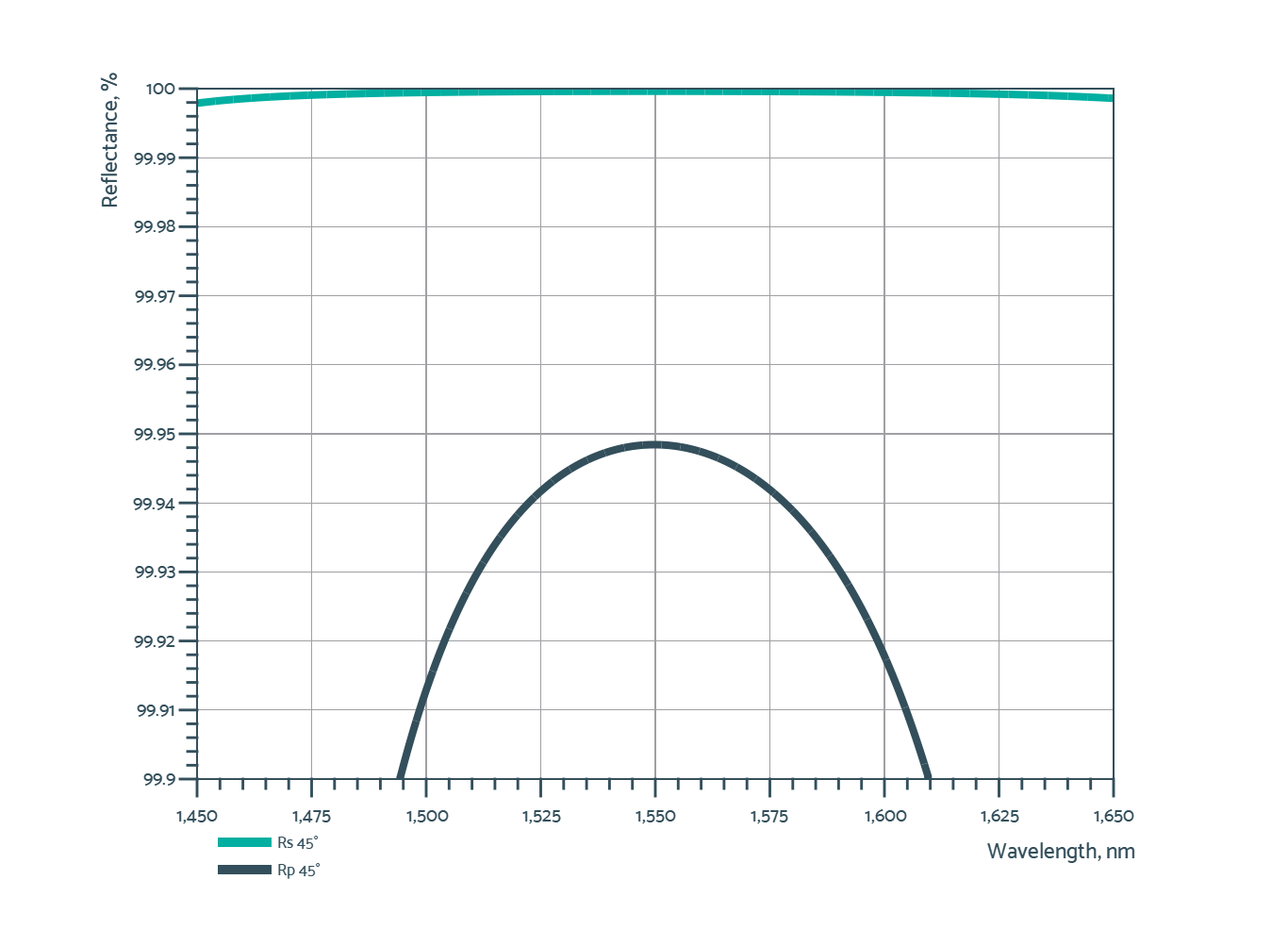1550 nm Optics for Laser Communication
With global data traffic surging, NASA, Airbus, and other industry leaders are accelerating the development of optical communication systems, which rely on lasers as the transmission source, enabling ultra-fast, high-capacity free-space optical links for ground-to-space, air-to-space, and inter-satellite connectivity.
Laser communication systems, as written in our Optical Challenges of Laser Space Communication whitepaper, are increasingly deployed for high-speed data transmission in both space and terrestrial environments, overcoming the inherent limitations of radio frequency (RF) communication.

Optical communication, which uses light to transmit information over long distances, operates in the optical spectrum, enabling vastly superior capacity, enhanced security, improved reliability, and reduced size, weight, and power (SWaP) requirements compared to RF systems. These advantages make laser communication a transformative solution for both Space Communications and Navigation (SCaN) missions and commercial free-space optical networks, delivering faster, more secure, and highly scalable connectivity.
Key parameters for laser communication include wavelength, beam divergence, power stability, and polarization, all of which directly affect link efficiency and data integrity. The 1550 nm telecom window, valued for its low atmospheric attenuation and eye safety, has become the industry standard for terrestrial and space-based optical communication. Commonly used sources include femtosecond and continuous-wave fiber lasers such as the Thorlabs FSL1550, Cycle SOPRANO, and Menlo Systems ELMO Erbium Laser. Supporting technologies like adaptive optics, fast steering mirrors, high-precision telescopes, and single-photon detectors are employed to maintain accurate beam delivery and reception, ensuring reliable operation even in turbulent or long-distance scenarios.
The 1550 nm telecom window, valued for its low atmospheric attenuation and eye safety, has become the industry standard for terrestrial and space-based optical communication.
Even with these advanced laser sources and supporting systems, significant operational challenges remain. The narrow beam profile of optical links requires ultra-precise pointing, while atmospheric interference from clouds, haze, or mist can disrupt transmission. To mitigate these issues, systems integrate advanced beam tracking, adaptive optics, and geographically distributed ground stations that provide weather-resilient links. Ultimately, the reliability of free-space optical communication depends on the quality of its optical components: absorption, scattering, coating defects, or surface errors in poor-quality optics reduce signal strength, distort the wavefront, and introduce stray light or polarization instability. These effects compromise data integrity, limit achievable data rates, and can ultimately shorten system lifetime. For this reason, free-space optical communication systems demand reliable space-grade optical components that combine excellent spectral performance, high environmental stability, and long operational lifetimes under extreme conditions.
Ultimately, the reliability of free-space optical communication depends on the quality of its space-grade optical components.
OPTOMAN’s Laser Communication optics directly address these challenges by eliminating the risks posed by inferior optical components. Manufactured using Ion Beam Sputtering (IBS), the coatings form a dense, amorphous structure that is fully resistant to mechanical wear, thermal cycling, and environmental fluctuations, including temperature and humidity. This stability eliminates absorption losses, scattering, and wavefront errors that can weaken signals and compromise data integrity in free-space optical links. IBS coatings provide near-scatter-free performance, exceptionally low absorption, and proven reliability in both terrestrial and space environments. By preserving link efficiency, ensuring polarization stability, and supporting long operational lifetimes, OPTOMAN’s optics offer a dependable foundation for mission-critical free-space optical communication (FSOC) systems.
Application Optimized Products
OPTOMAN’s IBS-coated Laser Communication Mirrors are engineered to deliver high reflectivity, minimal absorption, and high LIDT, making them a reliable choice for demanding laser applications. Optimized for operation at 1550 nm and a 45° angle of incidence, these mirrors ensure efficient beam control with exceptionally low loss and virtually no scattering in Laser Communication systems.
- High Reflectivity: HRs>99.95% & HRp>99.9% @ 1550 nm, AOI=45⁰
- Low Absorption: Minimizes thermal lensing and energy loss.
- Environmental Stability: Coating design suitable for environmental changes, thermal cycling, and mechanical wear.

OPTOMAN’s IBS-coated Dichroic Laser Communication Mirrors are engineered to provide precise wavelength separation by reflecting 640 – 780 nm at a 17° angle of incidence, while transmitting 1550 – 2500 nm with minimal absorption. Coated using IBS technology, these mirrors deliver long-term spectral stability and high contrast between transmitted and reflected beams.
- High Reflectance: HRp >98% @ 640-780 nm
- High Transmittance: HTsp >95% @ 1550-2500 nm, AOI=17° + ARsp <1% @ 1550-2500 nm, AOI=17°
- Environmental Stability: Coating design suitable for environmental changes, thermal cycling, and mechanical wear.


OPTOMAN’s IBS-coated Non-Polarizing Beam Splitters for Laser Communication engineered to split a 1550 nm wavelength laser beam into two virtually identical beams at a 45° angle of incidence, without disturbing the polarization ratio, making them a reliable choice for polarization-sensitive Laser Communication applications.
- High Beam Splitting Precision: Rs=50% +/-3% & Rp=50% +/-3% & |Rs-Rp|<3% @ 1550 nm, AOI=45°
- Environmental Stability: Coating design suitable for environmental changes, thermal cycling, and mechanical wear.
- Low Absorption: Minimizes thermal lensing and energy loss.

